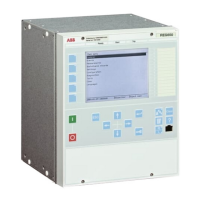For phase-to-ground measurement:
U UBase VT
VTprim
1
100
3
>
× ×
sec
IECEQUATION2426 V1 EN (Equation 26)
For phase-to-phase measurement:
U
UBase
VT
VTprim
1
100
>
× ×
sec
IECEQUATION2427 V1 EN (Equation 27)
4. Decrease the voltage slowly and note the reset value.
5. Set and apply about 20% higher voltage than the measured operate value for one
phase.
6. Measure the time delay for the TR1 signal and compare it with the set value.
7. Check the inverse time delay by injecting a voltage corresponding to 1.2 × U1>.
For example, if the inverse time curve A is selected, the trip
signals TR1 and TRIP operate after a time corresponding to the
equation:
IECEQUATION2429 V1 EN (Equation 28)
where:
t(s) Operate time in seconds
k1 Settable time multiplier of the function for step 1
U Measured voltage
U1> Set start voltage for step 1
For example, if the measured voltage jumps from 0 to 1.2 times the set start
voltage level and time multiplier k1 is set to 0.05 s (default value), then the TR1
and TRIP signals operate at a time equal to 0.250 s ± tolerance.
8. The test above can be repeated to check the inverse time characteristic at
different voltage levels.
9. Repeat the above-described steps for step
2.
6.6.2.2 Completing the test
Continue to test another function or end the testing by setting the parameter TestMode
to Off under Main menu/Tests/IED test mode/TESTMODE:1. If another function
is tested, then set the parameter Blocked to No under Main menu/Tests/Function test
modes/Voltage/OV2PTOV(59,2U>)/OV2PTOV:1 for the function, or for each
individual function in a chain, to be tested next. Remember to set the parameter
Blocked to Yes, for each individual function that has been tested.
1MRK 502 049-UEN A Section 6
Testing functionality
83
Commissioning manual

